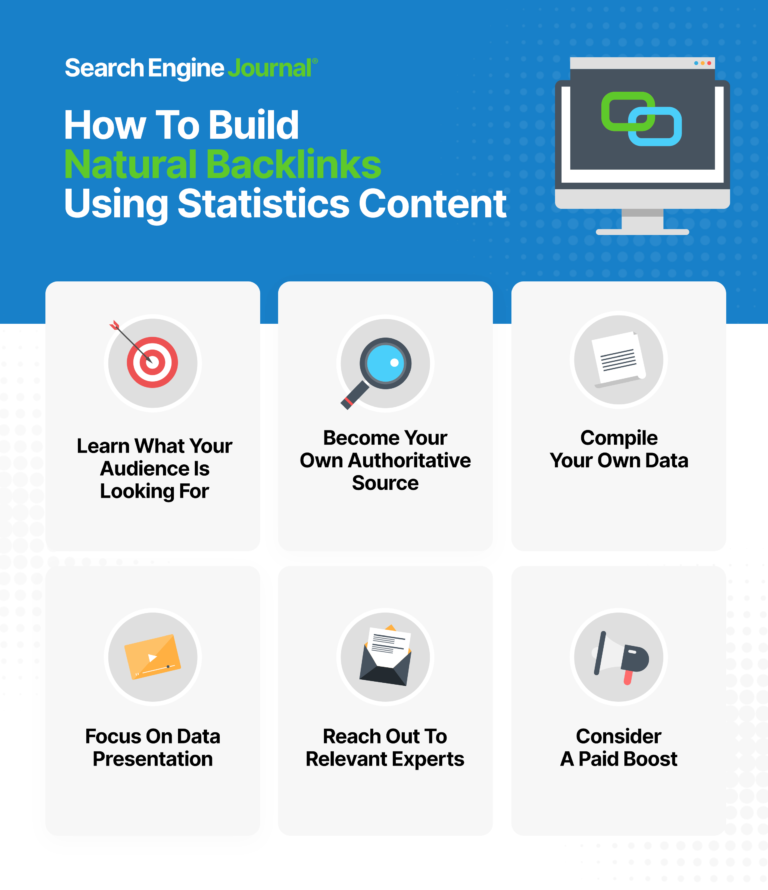Imagine you wake up at 8 a.m. bright-eyed and bushy-tailed, slurp down your first caffeine boost for the day, and sit down to do some cold but needed backlink outreach.
You’ve tried desperately for months, like a 5th-grade school girl crushing hard, to catch the attention of numerous link-worthy websites – only to get gut-wrenchingly turned down.
Ugh.
It’s too much effort for little return.
You’re at your wit’s end.
You’ve even forked over chunks of change for guest posts. And that hasn’t worked out so well either.
You know that the most organic way to scale is to create quality links, but how do you gain backlinks naturally?
Here’s my hot take: Use statistics content to generate natural backlinks by offering a great resource page for content creators.
This simple tactic sets you up for success and saves you plenty of time in the long run.
Let’s now take a look at how this works.
Why Should I Create Statistics Content As A Link Building Tactic?
As you already know, getting backlinks from cold email outreach can feel like finding a needle in a haystack.
Your email goes into their spam. They read it but don’t respond or respond months later and then ghost you.
Either way, it’s time-consuming and frustrating.
To make things even trickier, guest posts can eat up a lot of your marketing budget.
Content creation takes multiple people (writer, editor, designer, strategist) and time to truly be done well.
You want to make sure all content you create counts.
By focusing on educating your audience and crafting “less-salesy” content, you’ll set yourself up for success by attracting your ideal audience and seamlessly building links.
In return, when you cultivate more organic backlinks, your Domain Authority increases – slingshotting you toward page one of Google (hello, more sales!)
Quick note for the naysayers: As an SEO expert, I believe a metric like Domain Authority (though not Google confirmed) directly impacts SEO success.
Now back to the nitty-gritty: Getting natural backlinks with statistics content.
It Positions Your Brand As A Thought Leader
Mindfully crafting content with valid statistics for your consumer base, product, or industry is a simple way to position your brand as a thought leader.
When done correctly, others will look to you to provide solid, trustworthy data, creating sharing opportunities.
Now, at this point, I’d like to emphasize that gathering data doesn’t mean chewing up different stats from around the internet and spewing them back out again.
The data you choose to share should be as original as possible and directly relate to what you do as a business.
Although these types of posts can be more challenging to create since you’ll need to morph into your detective data-gathering mode, they are incredible assets for improving your website and your brand’s authoritativeness.
Content Creators Are Already Looking For It
Statistics are often used as a primary source of information, meaning they’re sought by content creators (journalists, marketers, bloggers, data analysts, market researchers, etc.) all the time.
With the rise of fake news, the responsibility to share trustworthy content is greater than ever, specifically for those with a larger following.
For this reason, creators are serious about sharing statistics that are accurate and transparent.
That’s why content creators actively seek brands like yours to help provide important statistics to back up their own content.
Content creators in your industry will likely refer to your content as their credible source.
It Gets Shared More Often
Simply put, people like numbers.
They want something tangible to grasp because data can back up ideas.
That is why content with statistics gets shared much more on both social media and blog platforms.
In fact, this works so well that it’s the center of a typical data-driven PR strategy.
Either way, it’ll help your social presence and backlink situation.
Talk about a win-win!
You Can Rank For It
Think about the creators in your industry.
What would they type into a search engine to find statistics?
If you’re in the beauty industry, maybe, “beauty statistics 2022.”
If you’re in the tech industry, possibly, “new tech statistics May 2022.”
Do you catch my drift?
Once you’ve put yourself in a creator’s shoes, you can use a keyword that’ll generate backlinks and rank organically.
And the more you rank, the more backlinks you’ll generate because you’ll get more clicks from the SERPs, meaning more organic traffic.
It should always be your main goal to create topics with keywords that have search volume.
In essence, you create an automated backlink accumulation machine (as long as those statistics stay timely and relevant).
Now you’re at the edge of your seat, wondering, “How can I take action on this?”
Buckle in. Here we go!
How To Build Natural Backlinks Using Statistics Content
For those who’d like a quick visual summary of the next section, take a look below:

Learn What Your Audience Is Looking For
It all starts with your people because there wouldn’t be a need to create content in the first place without them.
What types of content is your audience seeking?
What statistics would help them achieve their goals?
How can you help your audience inform their audience?
Look at this example:
If a newspaper had an audience of American sports fans, they might be interested in the number of gold medals the U.S. has received over the years in the Olympics.
This type of statistic may interest journalists writing about their forecast of the upcoming Olympics winners based on past results.
Think of this scenario like this: If you have reliable data related to sports, then your content might be used as the next source in CNN Sports.
Here’s another scenario: Startups may consider cities with the most entrepreneurs and how this number has grown over the years.
This data could help them decide where to relocate for the most optimal chance for success.
Sounds like a topic with credible research that might show up in a magazine like Entrepreneur.com, right?
Now you’ve got the idea!
Quick tip: To dive deeper into your audience’s interests, you can use a tool like BuzzSumo for the initial content research.
Become Your Own Authoritative Source
Instead of digging for data from others, make your own!
That’s how you become known for something as a brand. And if you’re worried you don’t have a huge amount of data, your content just needs to have a big enough sample to be relevant.
So remember, quality over quantity!
To determine how you can become your own source, ask yourself the following questions:
- What are we true experts on and can present credible data about?
- What do we have enough data on to present some findings based on that data?
- How can we create unique data that our audience finds useful?
- Where is there an information gap we can fill by providing relevant data?
- How does this data help what we stand for as a brand, especially our values, mission, and purpose?
When considering these factors, it becomes easier to hone in on what you’re truly an authority on and balance that with what your audience finds interesting.
By the way, another convenient factor in being your own authority is eliminating the dreaded citation loop.
A lot of times, sources are cited with nobody knowing where they originated, or when you do find the original source, you realize it’s data from decades ago.
If you happen to find a scenario like that in your industry, it might just be an information gap you can become a new authority on!
Compile Your Own Data
Now that you understand why being your own authority is the best route start to piece together your own statistics.
Depending on the type of data you need, you can create pools from channels like your website, social media, and customer data.
A few quick ways to gather data include:
- LinkedIn polls.
- Your own business analytics data.
- Qualitative or quantitative data about customers (if you’re allowed to share it).
- Market surveys.
- Expert interviews.
- Market research.
Quick tip: if you’re struggling to get a large enough sample, you can actually use a tool like SurveyMonkey to pay for survey responses from specific demographics.
This method saves a huge amount of time and is more objective than constantly asking your LinkedIn network to fill out a survey.
Focus On Data Presentation
Numbers jumbled up on a screen are confusing.
Your data needs to be accurate and purposeful, but it should also be visually appealing.
For instance, you can create an infographic that highlights the information in a simple manner.
Use branded colors, vivid designs, and appropriate UX to keep your audience’s attention.
Weaving in the data to a visual story is a sure-fire way to keep them scrolling and is also the perfect way to repurpose information across multiple channels.
Reach Out To Relevant Experts
Ever wondered why brands create content like “expert roundups?”
This is the reason: Brands compile data from credible subject matter experts and publish it on an owned channel like their website, then those experts want that exposure as well, so they share it, which in turn brings in more backlinks.
This might take some extra organizing, but creating your own data using niche experts is a great way for you and them to gain exposure.
Everybody’s happy!
Consider A Paid Boost
When you’re in the beginning stages and those organic rankings just aren’t there yet, consider a paid boost with Google Ads.
This way, you’ll boost your views, and if you’ve created content with keywords that have search volume, you can still get those backlinks.
Craft Link-Worthy Statistics Content To Generate Natural Backlinks
Link acquisition is not only the result of active outreach and content partnerships but a reflection of the quality and authoritativeness of your content.
And, as you may have guessed, in any good SEO strategy – link building and content creation should go together like Spongebob and Patrick.
To create “linkbait” content, it’s crucial to create content focused on the people actually creating the link.
In other words, to naturally generate backlinks with any piece of content, you should keep in mind content creators as your primary focus.
Now that you’re all in on crafting statistics content may the force be with you to generate those coveted natural backlinks!
More resources:
- The Top 5 Link Building Strategies (With Examples)
- Will Google Ever Fix the Big Brand Ranking Advantage of More Backlinks?
- Link Building Guide: How to Acquire & Earn Links That Boost Your SEO
Featured Image: Visual Generation/Shutterstock





